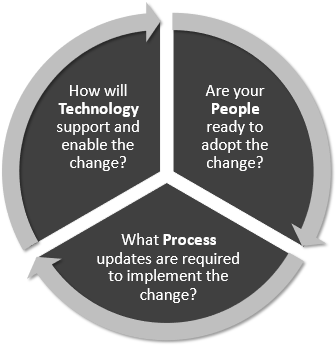Five steps to build a culture of continuous change and realize sustainable productivity results.
Axsium’s industrial engineers and workforce management specialists have spent decades identifying and implementing process improvements for our customers.
Regardless of whether process improvement is the primary focus of a project or a value-added opportunity that we uncover along the way, the Axsium team is always on the lookout for improvement opportunities. In fact, we encourage our clients to adopt the same mindset.
We have translated these insights and experiences into five straightforward steps to help your organization get started:
- Step 1: Get to know the proven methods
- Step 2: Get acquainted with the tools
- Step 3: Get your ideas prioritized
- Step 4: Get testing in the field
- Step 5: Get ready to adopt
Throughout this blog series, we’ve shared best practices on how to get thinking about, gathering, prioritizing, and testing your process improvement ideas. Now it’s time to get ready to adopt. In this final installment, we’ll explore a holistic framework to help you successfully and sustainably incorporate your ideas into everyday practice.
Step 5: Get ready to adopt.
On paper, many process improvement ideas seem like no-brainers. But to employees, especially those with longer tenure in your organization, some changes can be difficult to swallow. It’s relatively easy to fall into less-than-ideal process efficiencies, especially when you hear the words: “that’s how we’ve always done it”. And regardless of whether your people are aligned around the improvement ideas, they can sometimes feel overwhelmed if they have to process a lot of change at once.
Remember, your people will make or break your implementation. The success of your process improvement ideas depends on their ability and willingness to accept and adapt to the change. Change also involves managing the change itself.

The practice of Organizational Change Management (OCM) focuses on preparing, supporting, and helping individuals through changes. At Axsium, we consider all aspects of the change when developing our OCM strategies: People, Process, and Technology.
To illustrate the process, let’s go back again to our example from the second blog in our series, If you recall, we were talking about one retailer’s quest to usher in a more efficient inventory management process via tablet technology.
People: How ready is my organization for change?
Your people are the first thing you need to consider when preparing your organization to adopt a change. Your process improvement idea isn’t going to affect all individuals or groups in the same way, so a helpful way to start is by understand the range of those impacted directly versus those playing a more supporting role.
At Axsium, we call this the Stakeholder Analysis. Through facilitated workshops and direct interviews with subject matter experts, our consultants define the groups or key individuals that will impacted by the change. In our tablet example, this includes store and field leaders as well as technology, finance, and operations teams at corporate.
Once you’ve defined your key stakeholders, you need to identify how the change will impact them. We’ve put together a high-level example of how we assessed the impact of the tablets on the store manager group:

Prioritizing
Knowing how your stakeholders will likely be affected by the process change will help you focus your energy. You’ll need to prioritize front-line workers and employees who may be resistant or facing significant change in their daily work.
This process will also help you prioritize groups that could play an active role in supporting or championing the change. And this, in turn, will encourage the rest of your organization to successfully adopt the change.
Communication is a vital part of change management, and you’ll need to carefully craft your communications for each impacted group. Your stakeholders should understand how and when the change will affect them, as well as how you will handle support. It’s important to consider your stakeholders’ readiness and the degree of change they’re going to experience when tailoring the message.
In our tablet example, store operations were concerned that the inventory and counting process would be less accurate. We ensured that communications to store managers clearly outlined the training designed to ensure accurate counts. We also emphasized how the client could reallocate the saved time from this process change to other value-added activities and how that would benefit overall profitability.
Process: What training or tools will help drive adoption?
We discussed Standard Operating Procedures (SOPs) in Part 2 of this series. Most routine tasks in-store follow SOPs to ensure staff are performing them in the same way. Companies often display some SOPs in-store as diagrams, while employees commit others to memory. It’s not enough to update your SOPs to account for change—you need to make employees aware of the change and properly train them.
Training is an important part of not only learning the new process but also in processing the change. In addition to end-user training, you also need to train champions and supporters to help drive adoption. This includes keeping champion/support groups on all your communications and ensuring they can deliver end-user training. And most importantly, that training should clearly tell your end users how the change will affect them.
From a workforce management perspective, you will also need to update your labor standards. Break your improvements into micro-steps and eliminate any you’re no longer using from the standards. This will keep your labor forecasts and resulting schedules up to date.
Here’s the important thing, though—don’t update your labor standards right away. People don’t adopt change overnight, and your end users will likely need a short period to get used to it. Putting a small ramp up period in before fully updating your standards will help smooth the impact for those adopting the change.

Technology: How will the change be enabled and supported technically?
You have one last thing to consider in your process improvement implementation: technology. It is not only an important tool to help expedite the change (such as with mobility-friendly training or communications); it’s also often a key component to the change itself.
Take the tablet-based inventory process, for example. It was vital to procure the right tablet and inventory management software. We went through a formal process to consider the tablet and inventory software vendor options and pick the right one.
If you’re bringing technology into your day-to-day practices, you’ll want to assess the relative functionality and end user experience of your options. You’ll have to decide whether to do this through demos or a full-on RFP process. You’ll also need to think about how the new technology will integrate with your existing systems and reporting. And finally, make sure you provision, configure, test, and pilot the new technology before introducing it to your organization.
You may also need support tools to manage the change, or steady state for that matter. Unfortunately, technology doesn’t always work as designed. Set up troubleshooting FAQs and tips for end users, as well as more advanced troubleshooting techniques.
Large change implementations often need dedicated support teams, while you can route other implementations through IT support. For example, we provided store managers with troubleshooting tips if tablets wouldn’t connect to the store internet. In more complicated situations, such as when data migration issues arose, we advised store managers to contact a support team.

Conclusion
Process improvement projects can be incredibly beneficial and help your organization find ways to do more with what you already have. But ultimately, their success depends on whether you can successfully manage implementing the changes.
We hope you’ve found this primer on implementing your ideas through OCM helpful. If you need more information or support, reach out to our process improvement experts. Our change management practice has helped companies of all sizes usher in successful adoption by assessing impact and defining strategic communication and training plans.
And with that, we’ve completed our series on process improvement. If you’ve read all five blogs, then thank you for your engagement. And congratulations are in order—you are now officially (back) in the process improvement groove!

